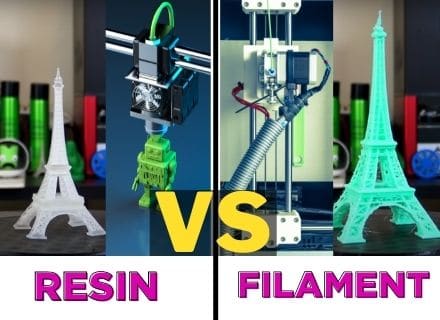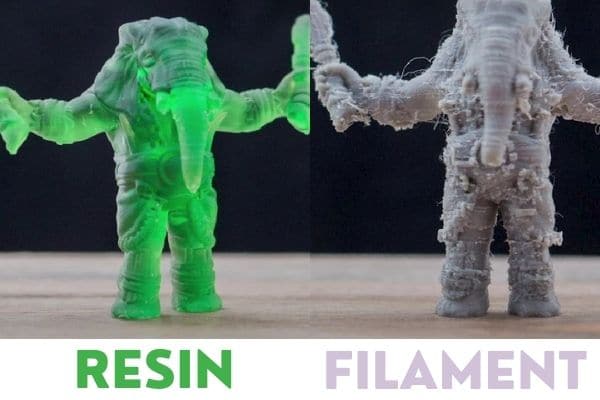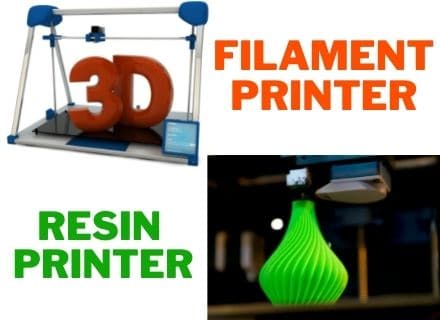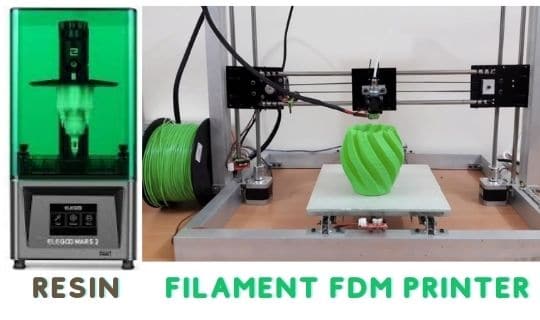
In this article, we will explore the tradeoffs of both Resin 3D Printer vs Filament. You might be asking: is one better than another? The answer depends on what type of project and why you want to use the 3D printer. Each technology has its own set benefits which makes them suited towards certain tasks over others.
Resin 3D Printer vs Filament
Which is the best way to make a 3d print? Some people might say that you should use a resin 3d printer, while others might say that filament is the way to go. So, which is better? Let’s take a look at the pros and cons of each option.
Short Answer for Resin 3D Printer Vs FDM Filament..
resin 3D printers and filament 3D printers are two very different types of machines. Filament printers are better for printing larger objects, while resin printers are better for printing smaller, more detailed objects. If you want to print a large 3D item or you want to finish your prints, then a filament printer is the best choice for you. On the other hand, if you want to print small models with high detail for business production, then we would suggest a resin printer over a filament printer.
Quick and Best 3D Printers to Choose:
Following are the best and quick suggestions for Resin 3D Printer vs Filament.
Resin 3D Printer: ANYCUBIC Resin 3D Printer
Filament FDM Printer: ANYCUBIC Vyper 3D Printer
How does Resin 3D Printer Works?
The Resin 3D Printers is also known as SLA or DLP printers are essentially 3D printing machines. These printers use UV lights and liquid resin to cure the material into layers. The cheaper versions shine an LCD image onto it which then becomes solid under friction from your print’s bed as soon as magic. You can print models with extremely fine detail far easier than traditional filament-based systems.
SLA/DLP printers use resin as the printing material. The resin is a photosensitive liquid that is hardened by a UV light source. This process results in prints with much finer details than filament printers can produce.
The downsides to resin printing are that it is more expensive and takes longer to print objects than filament printing does. However, the quality of prints that resin printers produce is far superior to filament prints. If you’re looking for a printer that can produce high-quality, detailed prints, then a resin printer is the best option available
What is FDM printing?
FDM printing is the most common type of printer. It uses melted plastic filament to print objects. The filament is fed into a hotend, where it is melted and then deposited onto the build plate in thin layers. This process creates prints that are relatively strong and durable.
The downsides to FDM printing are that it can be difficult to produce finely detailed prints. The prints often have a rough surface finish. However, FDM printers are much cheaper than resin or filament printers. And they can print larger objects than resin or filament printers can.
If you’re looking for a printer that is affordable and capable of printing large objects, then an FDM printer is the best option for you. A printer that can produce finely detailed prints, then we would suggest looking into resin or filament printers.
Resin 3D Printer vs Filament Comparision:
3D printers are an incredible innovation that allows for the production of real objects with many different uses. If you want to make anything from small toys, jewelry, or even large-scale architectural designs then this technology could be exactly what you’re looking for. To choose the best technology for your needs, there are a few important factors to consider.
Quality of 3D Print:
The resin printer is the ultimate for those who want to create high-quality work. With a smaller layer height, you can have more detail on edges and curves that couldn’t otherwise be printed with a standard plastic-bodied 3D Printer or Filament based printer. In my experience, I have found that resin printers offer the best quality for a 3D print. Unlike many other materials used in conjunction with Filament Printing Machines (FPM), UV Resin is able to produce extremely detailed prints.

Price and Affordability:
If we compare the Price and Affordability of Resin printers & Filament, the filament printer is a clear winner. These filament printers are more affordable as compared to resin with the resin printer. Although both types of
entry level printer has the same almost the same price from $250 to $300 but the difference is the ongoing cast. Filament printers use filament which is available around $30 to $40. And on the other hand, you can have a low-quality 500ml bottle of UV resin at the same price. Moreover, with the resin printer, you are required more materials like alcohol, films, and frames for the printer. Which are the additional cast you have to pay with the resin printer.
User Friendly: Which 3D Printer is easy to USe?
In my view UV resin printer is easy to start, whereas with a filament printer you have to level the bed out and find out the right heat for the nozzle and if it’s a heated bed. Adjusting the temperature for beginners is quite difficult. On the other hand, with a 3d resin printer, you need to level build the plate once and then pour in your resin pop on the lid and you hit print.
So in my experience, it is a lot easier to start with a resin printer but 3D printing is the messiest DIY hobby to Do.
Size of Print:
When it comes to printing larger parts, filament printers have a clear advantage. Standard resin printers’ smaller build volume can be limiting for those who need large quantities of prints at once and/or in high-quality formats like ABS or Polystyrene (PS).

The largest size you can print is with the currently available filament printer is 914.4 x 609.6 x 914.4 mm. Whereas with resin printer you can print a 9.6 x 7.8 x 4.8 inches.
The durability of Printed Part
When considering the orientation of parts, it is critical to maximizing strength. Resin printers have less integrity when forces act across layers but there are ways around this with appropriate setup and design in your project.
When you need to create parts with high durability, consider using a filament printer that uses standard plastics. Filament printer parts are more durable and can withstand substantial forces without breaking or cracking. Moreover, you have the use alternative materials like ABS and PETG to increase the strength of the parts because these types tend to be less brittle when forces act across layers.
Print Speed:
The resin printer is considered faster than the filament-based models because it only has one nozzle, which goes around and prints with UV resin. This makes for an entire layer in seconds; whereas a standard print head can take up to four minutes.
To give you an idea of how fast this printer works, let’s say for example that I have a job printing with UV resin. In total there are five different layers which take up about 30 seconds combined when doing them one at a time in traditional printers and 3-5 minutes each using the filament type printer.
Setup:
Resin printers are typically shipped nearly fully assembled. For the Elegoo Mars we use, only a few screws need to be tightened or loosened in order for its seat on top of your printer’s frame.

Whereas Some filament printers need to be assembled before the startup. The Creality CR-10 and Ender 3 Max have mostly assembled printers, while smaller models like the V3 take some time to put together. Leveling your print bed can be tricky but just needs a trial run before you get it right.
3D Software Setup and Installation:
Both printer’s software is easy to navigate and has an extensive range of customization options. There are easy and fewer settings required for For resin printers.
Materials and Colors supported by resin 3d printer vs filament?
Resin printers support a wide variety of materials and colors, while filament printers are limited to the types of plastic filament that they can use. Filament printers can only print in one color at a time, while resin printers can print in multiple colors simultaneously. This feature makes resin printers extra versatile than fila-ment printers.
If you’re looking for a printer that can produce prints in a wide variety of colors and materials, then we would suggest choosing a resin printer over a filament printer. However, if you need a printer that is affordable and capable of printing large objects, then an FDM printer is the best option for you.
Which 3D Printer has more Safety?
Although 3D printers are safe, but Some people worry about the safety of 3D printers. A filament printer has a hot nozzle that can easily burn you, and toxic fumes from melting plastic may also pose risks if not careful enough with ventilation in crowded spaces like homes or offices where they are used. The filament-based models produce very high temperatures but don’t have any special features needed to prevent accidents while using them – so long as one pays attention when handling their product.
Now when we’re talking about UV resin, well you’ve got the entire unsafe side of chemicals that are used in a process from your UV Resin to isopropyl alcohol. It can be dangerous if not wear protective equipment and just using skin as an unprotected target for these toxins.
FAQs:
Is resin 3D printing stronger than filament?
There is no clear answer, as the strength of 3D printed objects depends on a number of factors, such as the type of printer, the type of resin or filament used, and the settings used. However, generally speaking, 3D printing with resin is thought to be stronger than 3D printing with filament. This is because resin is typically a thicker material than filament, meaning that it has more layers and is, therefore, less prone to tearing or breaking. Additionally, the curing process that takes place when printing with resin results in a harder object that is less likely to deform or break.
Is filament faster than resin?
Resin 3D printers offer a higher quality print because they have more detailed prints than FDM machines.
Is resin cheaper than filament?
The resin 3d printers are more expensive than filament. Moreover, the material used for printing is also costly in the case of resin printers. Here is a breakdown of the costs for resin and filament:
1 kg of PLA filament = about $25
1 liter of resin = about $70
This means that the resin is more expensive than the filament. But there are some benefits to using resin that may make it worth the extra cost. For example, with filament, you are limited to printing in one color. While with resin you can print in multiple colors.







